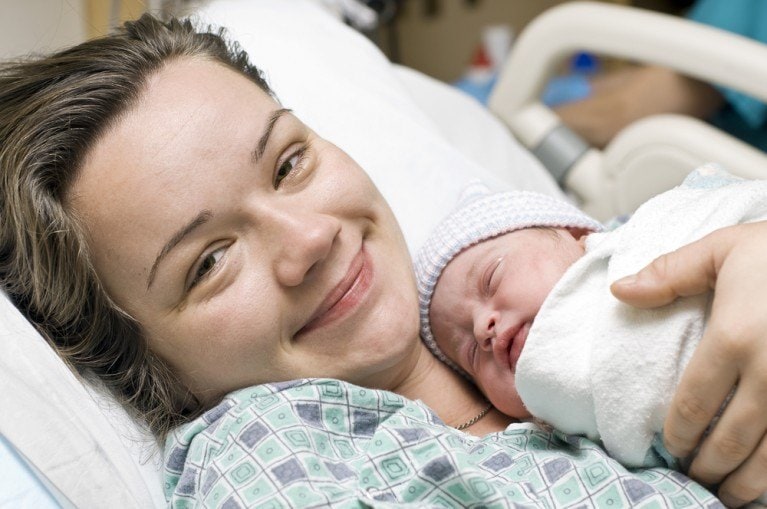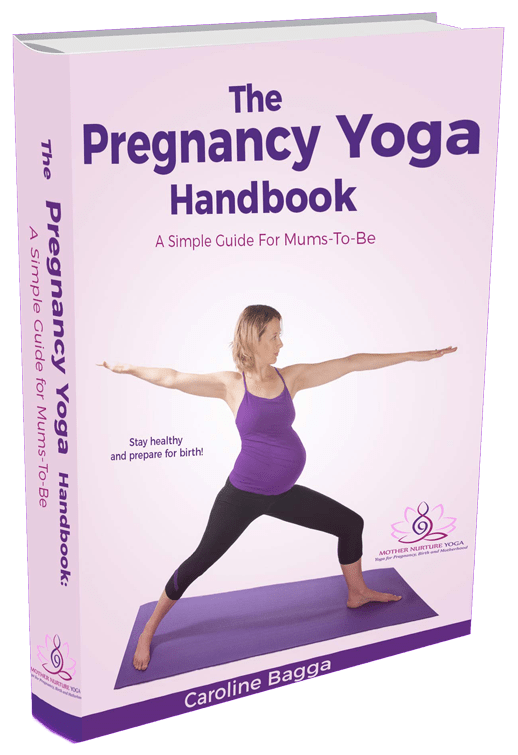Five easy tips which could make a real difference to your birth experience.
I’m 35 weeks pregnant with my second child and currently investing a lot of my head space on preparing for a beautiful natural birth. It’s been a long journey since my first birth which started with a post-dates induction and ended in an ‘emergency’ c-section. Since then, I’ve talked to many experts, read books, watched DVDs and generally educated myself about birth. I feel that I’ve done/am doing everything I can to ensure I have the best possible chance of giving birth the way I want it to happen. Much of this information is sadly not provided in the standard hospital ante-natal classes or the books that most women read in preparation. So I wanted to share this information with you in a simple and concise article.
So here it is…my top five tips for having a natural birth:
1. Choose your birth place and support team with care
The key to a strong support team is continuity of care from people you trust and who understand and support your wishes. Most women put the most thought into choosing their Obstetrician and the hospital that they want to go to. But that’s not enough – during a ‘normal’ labour these factors are almost completely insignificant. If everything is progressing smoothly the OB won’t come in until the end and you honestly won’t notice the colour of the wallpaper. Of course if there is a true emergency then you will be thankful for the hospital’s fantastic medical facilities and your OB’s expertise.
But in a normal birth your main care provider for the majority of the labour will be a midwife, and unless you’re lucky enough to be assigned a specific midwife then it’s luck of the draw on the day as to who happens to be on shift. While most midwives believe that birth is a natural occurrence (as opposed to a ‘medical event that needs to be managed’) the chances are you won’t have met the midwife before and they may or may not provide support and convey information in the way that you would like. They will also be looking after multiple women at the same time which means they will be in and out of the room throughout your labour.
And so the main role of support person falls to your husband/partner, which is a big ask for someone who has never experienced birth before and probably feels like a fish out of water in the hospital labour ward. Make sure your husband/partner is well educated about labour and birth (see Tip 3), understands your birth wishes and how you plan to deal with the ‘pain’ of labour. But be realistic about the support that they are actually able to able to offer you – don’t expect them to suddenly turn into the world’s best masseuse for example!
You may like to consider hiring a Doula and/or an independent midwife who can provide continuity of care throughout your pregnancy, labour and birth. A doula – a non-medically qualified birth support person – can provide the emotional and physical support that you need both at home and in the hospital. Many of them are skilled in massage and have strong emotional intuition. They know how the hospital system works and can tactfully help you to navigate that to safely achieve the birth you want. They can provide the emotional coaching that you need if things start to ‘go wrong’ or get tough for you. For example, if they see you in pain your husband/mother/friend might start to waver and suggest pain relief, whereas a doula on the other hand would have the skill to refocus your awareness internally and press on acupressure points to provide natural pain relief. And even your husband is the most amazing support person in the world, if the labour is long it will become difficult for them to sustain the level of support that you will need throughout so they can tag-team with the doula. A caution here though: choose a doula with enough diplomacy, skill and experience of working in the particular hospital you are going to give birth in. The labour ward is no place for egos and a battle of wills between members of your support team.
An independent midwife would also be wonderful (and in some regards the best option as they are medically trained which enables them to weigh up medical advice with emotional support while remaining accountable yet unconstrained by the particular hospital’s policies) but it depends on being able to find one with visiting rights to your particular hospital and having the budget to pay for it (usually they are about five times the price of a doula).
In terms of the birth place, your choices are usually: Private hospital, Public hospital, Birth Centre or Home Birth. Most women make the choice based on a number of factors including their level of private health insurance, proximity of hospitals, personal recommendations and where they feel most comfortable. The latter point is very important because environment plays a significant role in how your birth experience unfolds – put simply, if you feel safe and comfortable the ‘love hormones’ of birth (oxytocins and endorphins) will flow as they are meant to. If you feel threatened or anxious then these hormones will be overtaken by adrenaline which will create pain in your body. If you are choosing a hospital birth don’t be afraid to ask for their policies and intervention rates – you may be surprised. This will differ by OB too, so make sure the place of birth and your primary care provider is supportive of your wishes.
Further reading: http://www.findadoula.com.au
2. Prepare your body for birth
Physically you can prepare your body throughout your pregnancy. Pregnancy yoga is great for strengthening your body, in particular your legs and back, which will help as your baby grows.
Getting your pelvis ready for birth is critical. As the hormone ‘relaxin’ loosens up all your ligaments you may find your pelvis becomes unstable. The extra weight of the baby also tends to play havoc with your lower back. Both these factors can mean that it becomes harder for your baby to find it’s way out. Find a good Osteopath and visit regularly, particularly from week 32 to help fine-tune your pelvic area.
Your uterus will be working really strongly during labour so you can help this amazing muscle by taking supplements such as Raspberry Leaf (from third trimester) and visiting an Acupuncturist who is specialised in providing pregnancy support. The purpose is to ‘tone up’ your uterus and increase the blood supply. Acupuncture has the added benefit of helping to get baby into the right position and can be an effective form of natural induction if started early enough (see tips 4 and 5).
3. Prepare your mind for birth
Knowledge is power so if you are a first-time parent, make sure you complete a comprehensive course in childbirth education. Most hospitals offer ante-natal courses but there are also some great independent midwife-led courses which can potentially provide a more objective view than the information provided by the hospital system. Understand the theory of pain and how your body’s hormones are supposed to work during labour.
Courses such as Calmbirth and Hypnobirthing are also growing in popularity as women come to realise that birth is both a physical and mental event. If you are in the right state of mind you can enter “Labour La La Land” where everything just seems to flow and you become oblivious to time and external happenings. As far as I can tell, most of the content in these courses is based on ancient yogic teachings about achieving mind-body connection through the breath, therefore increasing the hormones that help manage pain (oxytocins and endorphins) and decreasing adrenaline in order to produce a more efficient and “less painful” labour. Try a few different breathing and meditation techniques then find one that works for you, stick to it, and practice it regularly. If you find it hard to practice by yourself, go to a regular prenatal yoga class which will give you the opportunity to practice relaxing and breathing through potentially uncomfortable sensations.
Surround yourself with positive suggestions/affirmations, birth stories and women who are of the same mindset. Your mind has the potential to be your biggest ally during labour – you just need to train it in advance. Practice ‘being present’ in the moment – right here, right now. The realisation that labour is a temporary event can be massively liberating. Like eating a hypothetical elephant, if you can just deal with one contraction at a time you will eventually get there.
Further reading:
Guide to Childbirth, Ina May Gaskin
Gentle Birth, Gentle Mothering, Sarah J Buckley
4. Get your baby into the right position
Many of us nowadays work in office jobs that involve a lot of sitting around during the day, and then in the evening we come home to lay back and relax on the sofa. This sedentary lifestyle is contributing to a rise in babies who are in a posterior position. Without getting too technical, this means that your baby’s spine is against your spine, as opposed to the ideal Anterior position with their face being towards your spine – and this means a longer and harder labour with strong back pain.
It is good to start thinking about this from an early stage so you can create good habits, but from around 34 weeks the concept of ‘Optimal Fetal Positioning’ becomes critical, especially if this is your first baby, because bub will become engaged in your pelvis ie. locked into position. If it is not your first baby the baby is unlikely to engage but it is still good to get them used to lying in an anterior position (spine outwards).
So how do you get baby into the ideal position? Basically lots of leaning forwards instead of backwards. If you are sitting then ensure your spine is upright or you can lean forwards (onto a table for instance). You may be advised to crawl around on your hands and knees or scrub the floor! Many prenatal yoga poses are on hands and knees for this very reason (and are a lot more pleasant than scrubbing the floor!!) If you want to relax then lie on your left side. For example, if you want to relax watching TV then lie along the couch on your left side rather than reclining in a lazyboy chair.
Further reading:
www.spinningbabies.com
Sit Up and Take Notice: Positioning for a Better Birth, Pauline Scott
Or Google ‘Optimal Fetal Positioning’
5. Say no to induction (unless it is medically necessary)
I guarantee this is the most controversial of my tips. Let’s be clear – I’m not talking about scenarios where it is medically necessary and beneficial eg. pre-eclampsia or fetal distress. I’m talking about a scenario where the woman is ‘overdue’. I am a firm believer that your baby will come when it is ready. Shockingly, a large number of inductions for post-term pregnancies result in a cascade of intervention which ultimately ends in an ‘emergency’ c-section. A study of 28,626 women by the University of Adelaide found that induction of labour was associated with a 67% increased relative risk of cesarean section (compared with spontaneous labour).
Most private hospitals have policies that only allow you to go past your due date by 1 week with public hospitals allowing you up to 10 days. Remember that a normal gestational period is 38 – 42 weeks, and most first births deliver around a week after their due date. Therefore most inductions happen before what is necessarily ‘full term’ ie. between 40 and 41 +3 days. These policies are primarily for the hospital/OB’s scheduling convenience and insurance policies, although they will probably tell you it is for the safety of your baby. Yes it is true that there is a higher incidence of stillbirth the longer you wait – however that statistic is based on a very tiny base rate – a UK study found that at 40 weeks the risk is 1:926 while at 42 weeks the risk increases only slightly to 1:769. Most studies and health professionals agree that up to two weeks ‘overdue’ is usually absolutely fine as long as there are no other risk factors and the baby is well monitored.
This risk can also be managed by monitoring amniotic fluid levels, baby’s movements and heart rate. Know your rights and know that you can refuse an induction IF you want to. You may not want to, but the point here is that there are other options if you’re not comfortable with an induction at 41 weeks. Tune into your intuition (this is good practice for your upcoming journey of being a parent!) and don’t be pressured into making any decisions that don’t feel right. A mother’s intuition is rarely wrong and if you can put your mind to rest by some additional monitoring, there’s absolutely no rush to get baby out. The best thing you can do is relax and enjoy the final days of your pregnancy.
So that’s my top tips. Some of them may challenge your thinking but ultimately I hope that at least one or two of them will benefit you in creating your own ideal birth experience. Remember though, often when the action starts, the birth plan that you envisaged can go out of the window. And that’s ok as long as you feel happy that you have done everything you can, that you were in control and comfortable with the decision-making process. Happy birthing!
If after reading this article you are inspired to try a Pregnancy Yoga class I offer Prenatal Yoga classes in Carlingford at 9:30am on Saturdays. See mothernurtureyoga.com.au for more information.

Give birth with confidence – join our Couples Birth Preparation course







